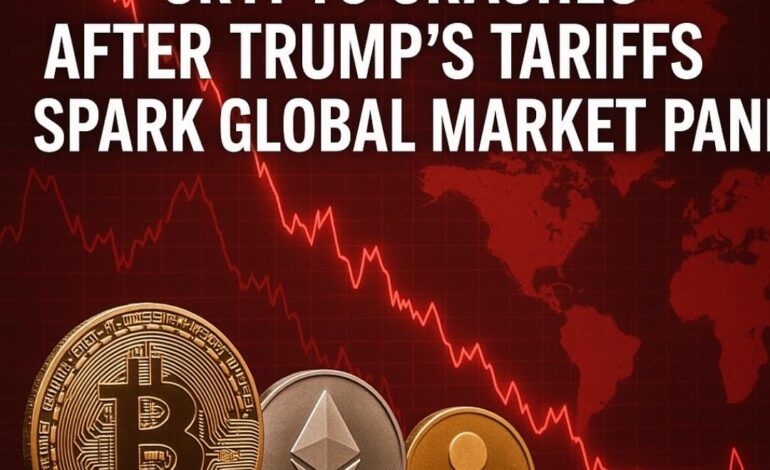
Crypto Crashes After Trump’s Tariffs Spark Global Market Panic
Crypto Crashes: The cryptocurrency market faced a sharp downturn on Friday following President Donald Trump’s announcement of modified “reciprocal” tariffs targeting dozens of countries. The announcement rattled global markets, triggering risk-off sentiment and a rapid sell-off in digital assets.
Bitcoin (BTC) led the decline, falling by 3% to $113,231.41, while Ether (ETH) and Solana (SOL) registered steeper losses of 6% and 5%, respectively. The abrupt descent also unleashed a wave of long liquidations, further amplifying the downward pressure on prices.
$490 Million in Liquidations Fuel the Decline
In the past 24 hours, Bitcoin saw $228 million in liquidations across centralized exchanges, while Ether liquidations totaled $262 million, according to data from CoinGlass. Long liquidations occur when traders are forced to sell their assets at market prices to settle margin calls, exacerbating price declines during sell-offs.
Crypto Stocks Plunge Alongside Digital Assets
Crypto-linked equities faced even deeper losses:
- Coinbase (COIN) dropped 16%, hit by a disappointing Q2 earnings report.
- Circle (USDC issuer) fell 8.4%.
- Galaxy Digital declined 5.4%.
- Bitmine Immersion, an Ether treasury company, lost 7.4%.
- MicroStrategy, often viewed as a Bitcoin proxy stock, plunged 8.7%.
The broader sell-off came as Trump’s tariffs—ranging between 10% and 41%—sparked concerns over rising inflation and the Federal Reserve’s flexibility to cut interest rates. In times of increased economic uncertainty, investors tend to retreat from speculative assets, with cryptocurrencies typically among the first to be sold off.
A Healthy Cooldown, Not a Crisis
Despite the sharp pullback, analysts suggest this is a “strategic cooldown” rather than a panic-driven crash.
“After running red hot in July, this is a healthy strategic cooldown. Markets aren’t reacting to a crisis, they’re responding to the lack of one,” said Ben Kurland, CEO of DYOR, a crypto research platform. He noted that with no fresh macro catalysts on the horizon, investors are rotating capital from high-risk assets to safer instruments.
Bitcoin and Ether, however, continue to show technical resilience, supported by steady institutional demand. Kurland emphasized that this isn’t a breakdown in fundamentals, but a temporary pause driven by macroeconomic shifts.
July Was a Strong Month for Crypto
The sell-off follows an exceptionally strong July for the crypto market:
- Bitcoin gained 8%, according to Coin Metrics.
- Ether surged over 49% during the month.
Notably, Ether ETFs attracted over $5 billion in inflows in July, with only a single day of outflows totaling $1.8 million on July 2. This brought cumulative inflows to $9.64 billion. In contrast, Bitcoin ETFs saw $114 million in outflows on the last trading day of July, though their total monthly inflows still stood at $6 billion, with cumulative inflows of $55 billion to date.
Outlook: Volatility Ahead Amid Low Volumes
August is historically marked by lower trading volumes and higher volatility. With macro uncertainty looming large due to tariff impacts and inflation fears, market participants are bracing for potential turbulence.
While the immediate reaction to Trump’s tariff announcement has been negative, long-term bulls remain cautiously optimistic, citing the strong institutional appetite for digital assets as a stabilizing force.
Also Read: The Hidden Health Insurance Risk After 60






